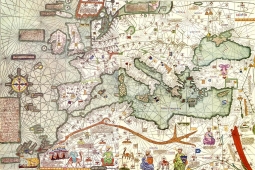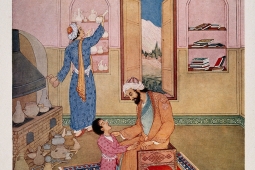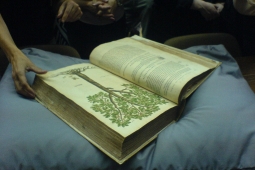The Spread of Disease along the Silk Roads: The Significance of Cultural Exchange in Alchemy and the Later Development of Chemistry - Part. I
©Triff / Shutterstock.comThis article is the fourth in a series on the ways in which societies have historically responded to disease along the Silk Roads and how we might approach newly arising challenges today. It utilizes the Silk Roads as an instructive example of the benefits of an interconnected world built on collaboration and timely and reliable knowledge sharing. This article, divided into two parts, outlines the practice of alchemy as a precursor to the development of the scientific discipline of Chemistry, in turn an important element of the medical sciences. In doing so it identifies the role of the Silk Roads in helping fuel an incredible period of scholarship, particularly within the field of medical sciences, during the 8th and 9th centuries CE.
Interactions across vast distances, such as those which took place along the historic routes of the Silk Roads, have made an undeniable contribution to the enrichment and development of the sciences via the transmission of both knowledge and the material resources for scientific enquiry. Some important proto-scientific disciplines developed along the Silk Roads include medical botany, pharmacology, early responses to infectious disease, and the precursor to the scientific discipline of chemistry - alchemy. Historically, in the case of alchemy and early chemistry, exchange created the conditions favourable to accessing the natural resources required, including the metals and mineral deposits found throughout Central Asia, as well as to diverse bodies of existing knowledge particularly ancient scientific and philosophical texts from Ancient China, Egypt and the Indian subcontinent.
Modern day chemistry is the scientific discipline concerned with elements and compounds composed of atoms, molecules and ions, and their composition, structure, properties, behaviours, and the changes they undergo when they react with one another. It has an incredibly diverse range of practical applications ranging from energy and food production, to building materials, cosmetics, and the development of the medical sciences. Scientific enquiry and method in chemistry had an early proto-scientific precursor in the art of ‘alchemy’, an ancient field of natural philosophy concerned with the purification and perfection of certain materials, the transformation of base metals such as lead into those perceived to be more valuable such as gold, and the creation of panaceas to cure all known illness and disease. Alchemy was a prescientific practice observed throughout many parts of Eurasia and Africa, particularly in China and Europe. It is believed to have been an area of study in China and the Greco-Roman world from as early as the first century CE. Along the Silk Roads, the vast natural deposits of metals in Central Asia encouraged the practice of alchemy and experimentation with metallurgic materials giving rise to an incredibly large number of treatises on the subject.
Although humans began utilising some of the earliest technologies that would go on to form the basis of chemical enquiry from as early as 1000 BCE, such as fire, extracting metals from ores, making pottery and glazes, extracting chemicals from plants for their medicinal properties, making glass, and producing alloys such as bronze, it was not until much later that there were concrete attempts to conduct written studies in chemistry motivated in large part by the potential for uncovering substances with medicinal properties and uses. The earliest written works on chemical process and transformations arose from a number of centres throughout the ancient world, including Egypt, Mesopotamia, the Indian Subcontinent and China.
Later, during the Islamic Golden Age of the 8th to the 14th century CE, Arabic-speaking scholars translated many of these Greek, Chinese, and Indian scientific and philosophical works on alchemy into Arabic in flourishing academic centres such as Baghdad, Cairo, Samarkand and Bukhara. Thereafter, philosophers in the Islamic world pursued chemical and alchemical ideas from across the reaches of the Silk Roads with great enthusiasm and success. The elemental system utilized in medical alchemy was primarily developed by the Persian-Arab alchemist, Ibn Hayyān and was derived in parts from the classical elements of the ancient Greek tradition, namely the four Aristotelian elements of air, earth, fire and water as well as sulphur and mercury. During the mid-10th century CE, Abu Abd Allah al-Khwarazmi created an encyclopaedia of technical terms, Keys of the Sciences (Mafatih al-ulum) in which he described the three constituent elements of alchemy, the apparatus used, the chemical substances required, and their interactions and processing. Indeed, the large number of modern chemical words in the English language which are derived from Arabic, such as alkali, alchemy, zircon, elixir, and many others, attest to the great importance of this period in the development of chemistry as a scientific discipline.
“Part two of this article series will continue by exploring the role additional parts of Central Asia, outside of the major city centres, played in the development of alchemy and early chemistry practices. It identifies the alchemical resources uncovered at archaeological sites which have allowed us to better understand the natural resources, materials and technologies used and exchanged along the Silk Roads in the development of this important field of the sciences.”
Related articles

The Spread of Disease along the Silk Roads: Plague
This article explores the spread of plague, known as ‘the Black Death’, across the Silk Roads of the 14th Century CE. It examines ways in which people responded to the disease and looks at how we can respond to newly arising challenges today, utilizing the Silk Roads as an instructive example of the benefits of an interconnected world built on collaboration and timely and reliable knowledge sharing.

The Spread of Disease along the Silk Roads: Smallpox
This article is the second in a series on the spread of disease along the Silk Roads. It details the spread of smallpox along the Silk Roads and the transmission of novel public health measures to combat it, including variolation and later, vaccines.

The Spread of Disease along the Silk Roads: The Development of Medical Botany and Pharmacology
This article is the third in a series on the spread of disease along the Silk Roads. Its outlines the early development of medical botany and pharmacology during the Middle Ages and identifies the role of the Silk Roads in helping fuel an incredible period of scholarship, particularly within the field of medicine, during the 8th and 9th centuries CE.




